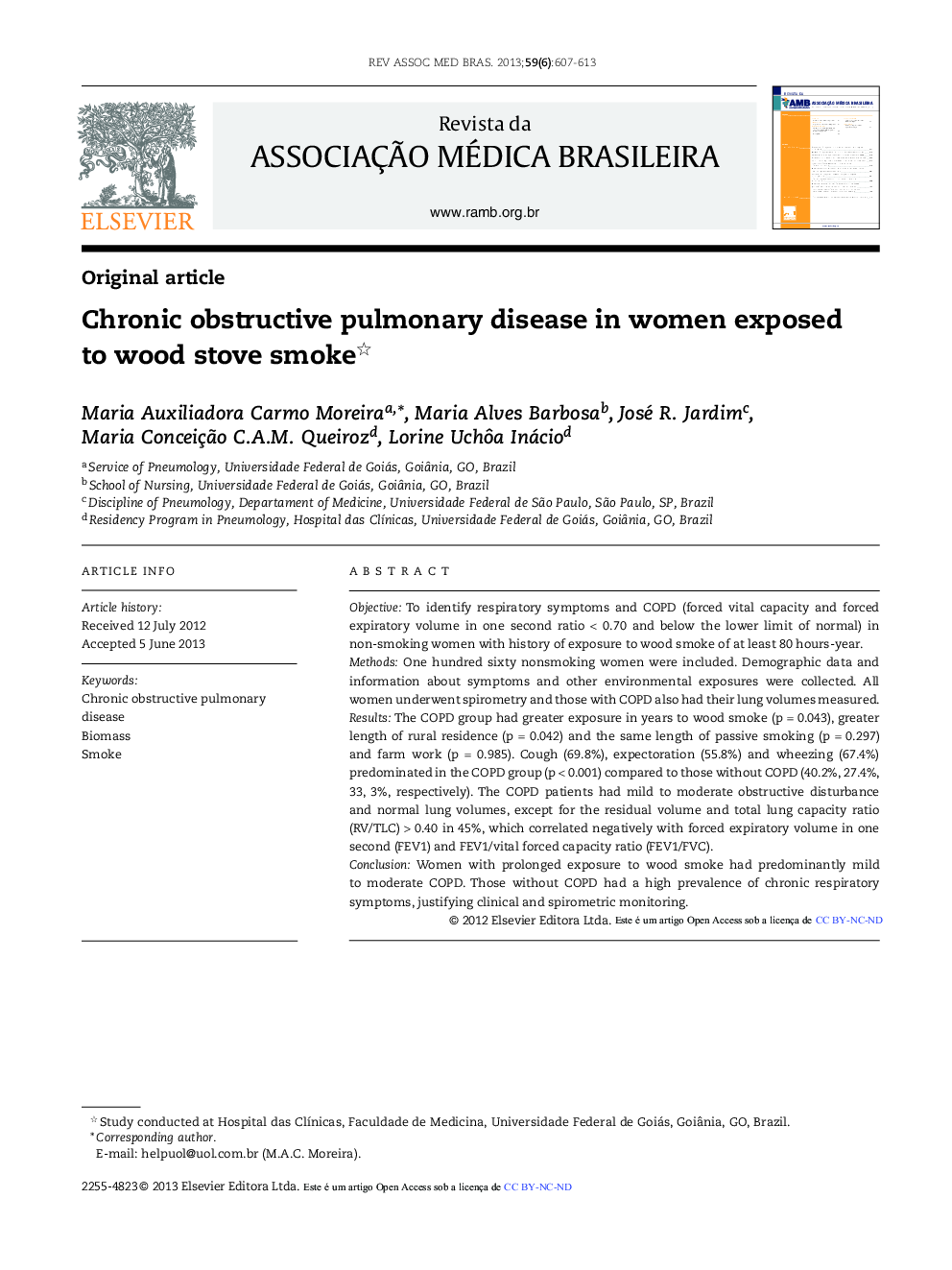| کد مقاله | کد نشریه | سال انتشار | مقاله انگلیسی | نسخه تمام متن |
|---|---|---|---|---|
| 3826664 | 1597805 | 2013 | 7 صفحه PDF | دانلود رایگان |

ObjectiveTo identify respiratory symptoms and COPD (forced vital capacity and forced expiratory volume in one second ratio < 0.70 and below the lower limit of normal) in non-smoking women with history of exposure to wood smoke of at least 80 hours-year.MethodsOne hundred sixty nonsmoking women were included. Demographic data and information about symptoms and other environmental exposures were collected. All women underwent spirometry and those with COPD also had their lung volumes measured.ResultsThe COPD group had greater exposure in years to wood smoke (p = 0.043), greater length of rural residence (p = 0.042) and the same length of passive smoking (p = 0.297) and farm work (p = 0.985). Cough (69.8%), expectoration (55.8%) and wheezing (67.4%) predominated in the COPD group (p < 0.001) compared to those without COPD (40.2%, 27.4%, 33, 3%, respectively). The COPD patients had mild to moderate obstructive disturbance and normal lung volumes, except for the residual volume and total lung capacity ratio (RV/TLC) > 0.40 in 45%, which correlated negatively with forced expiratory volume in one second (FEV1) and FEV1/vital forced capacity ratio (FEV1/FVC).ConclusionWomen with prolonged exposure to wood smoke had predominantly mild to moderate COPD. Those without COPD had a high prevalence of chronic respiratory symptoms, justifying clinical and spirometric monitoring.
ResumoObjetivoIdentificar sintomas respiratórios e DPOC (relação entre volume expiratório forçado no primeiro segundo e capacidade vital forçada < 0,70 e abaixo do limite inferior da normalidade) em mulheres não fumantes, com história de exposição à fumaça da combustão de lenha de ao menos 80 horas-ano.MétodosForam incluídas 160 mulheres não tabagistas. Coletaram-se dados demográficos, sintomas e informações sobre outras exposições ambientais. Todas as mulheres realizaram espirometria e aquelas com DPOC também medidas de volumes pulmonares.ResultadosO grupo com DPOC apresentava maior duração de exposição, em anos, à fumaça de lenha (p = 0,043), maior tempo de domicílio rural (p = 0,042), duração similar de tabagismo passivo (p = 0,297) e de trabalho na lavoura (p = 0,985). Tosse (69,8%), expectoração (55,8%) e chiado (67,4%) predominaram no grupo com DPOC (p < 0,001) quando comparado ao grupo sem DPOC (40,2%, 27,4%, 33,3%, respectivamente). As pacientes com DPOC apresentavam distúrbio obstrutivo leve a moderado e volumes pulmonares normais, exceto a relação entre o volume residual e a capacidade pulmonar total (VR/CPT) > 0,40 em 45%, que apresentou correlação negativa com o VEF1 e VEF1/CVF.ConclusãoMulheres com exposição prolongada à fumaça de lenha apresentaram DPOC predominantemente leve a moderado. Aquelas sem DPOC tiveram alta prevalência de sintomas respiratórios crônicos, justificando monitoramento clínico e espirométrico.
Journal: Revista da Associação Médica Brasileira (English Edition) - Volume 59, Issue 6, January 2013, Pages 607-613